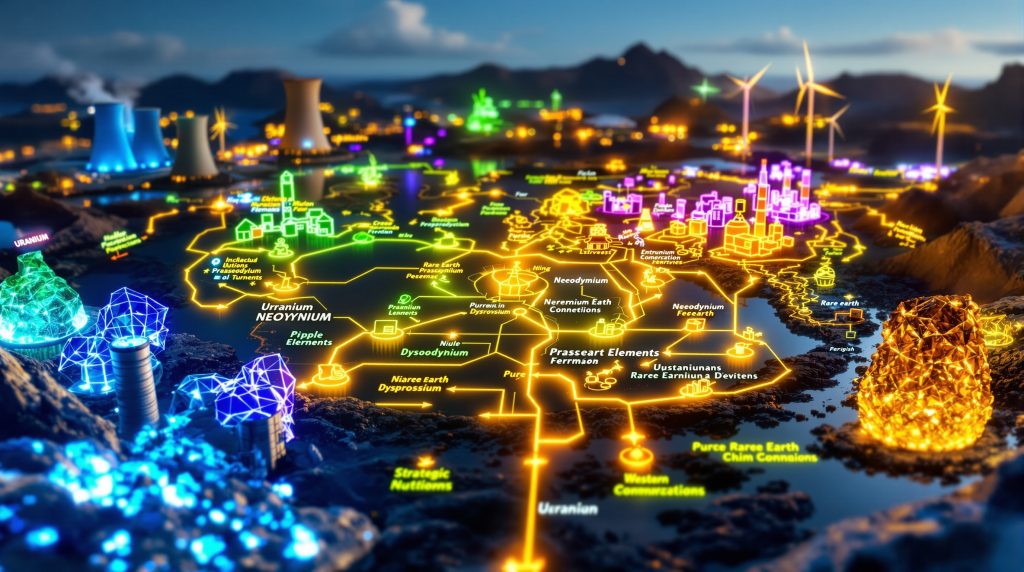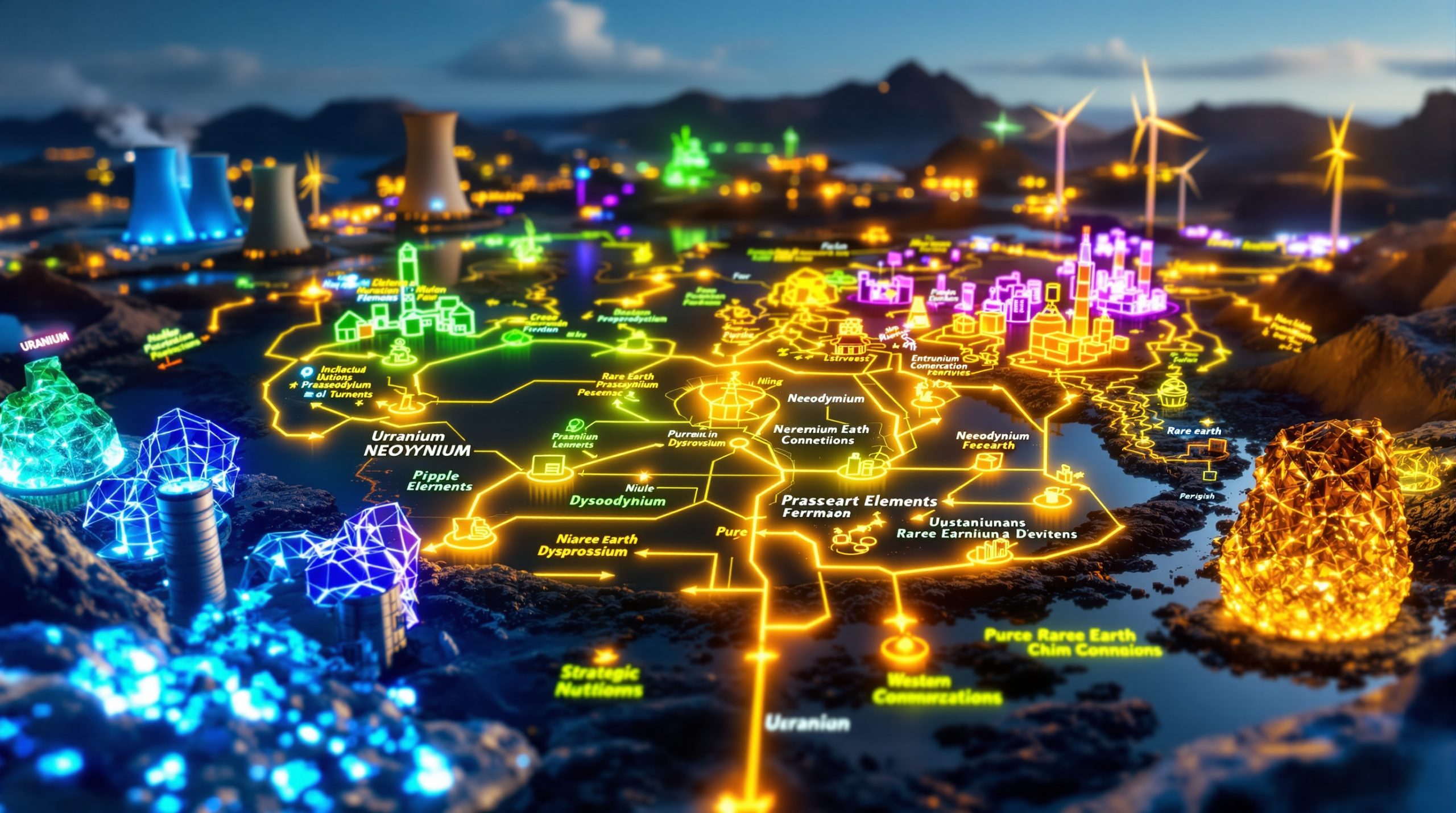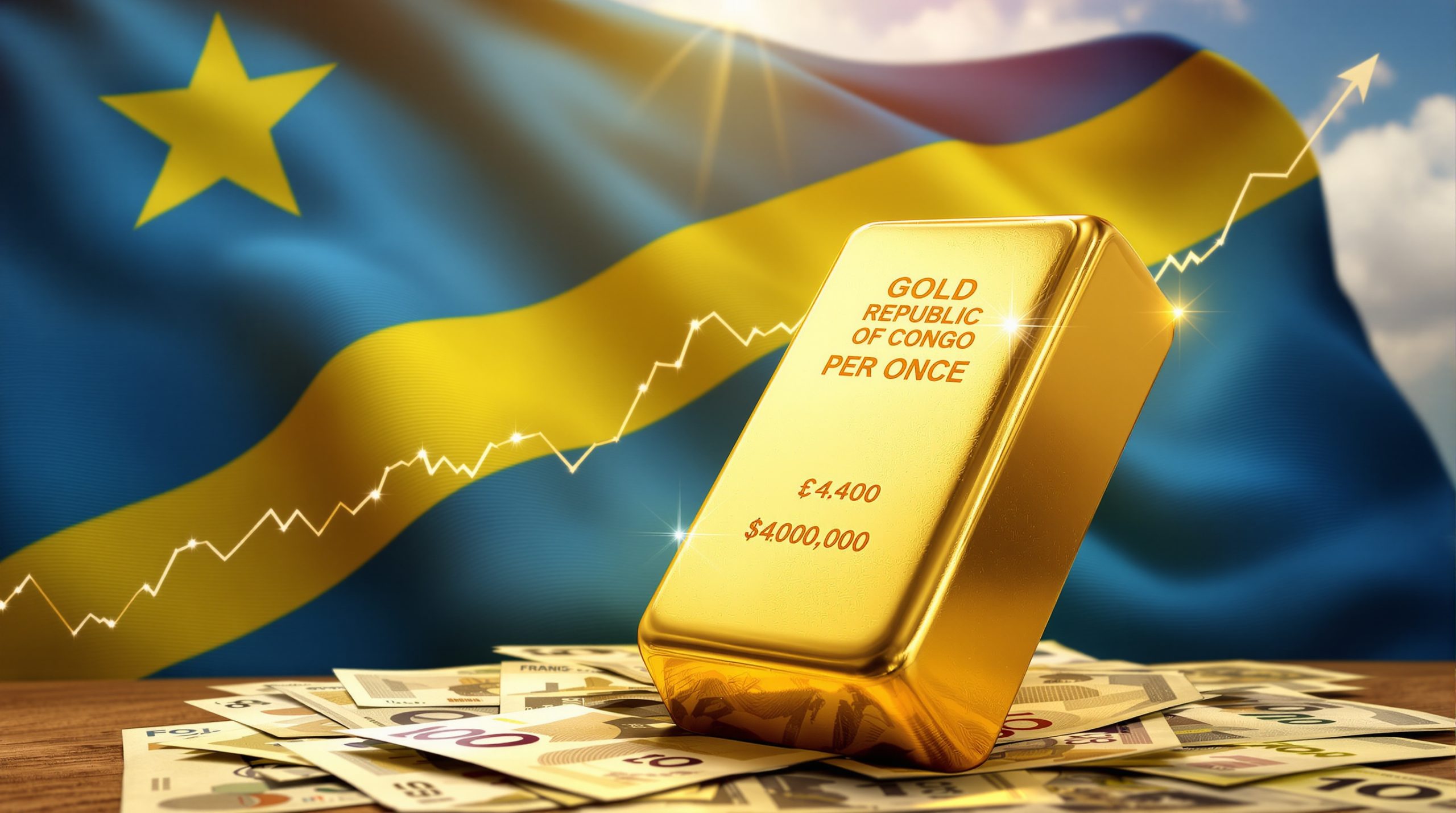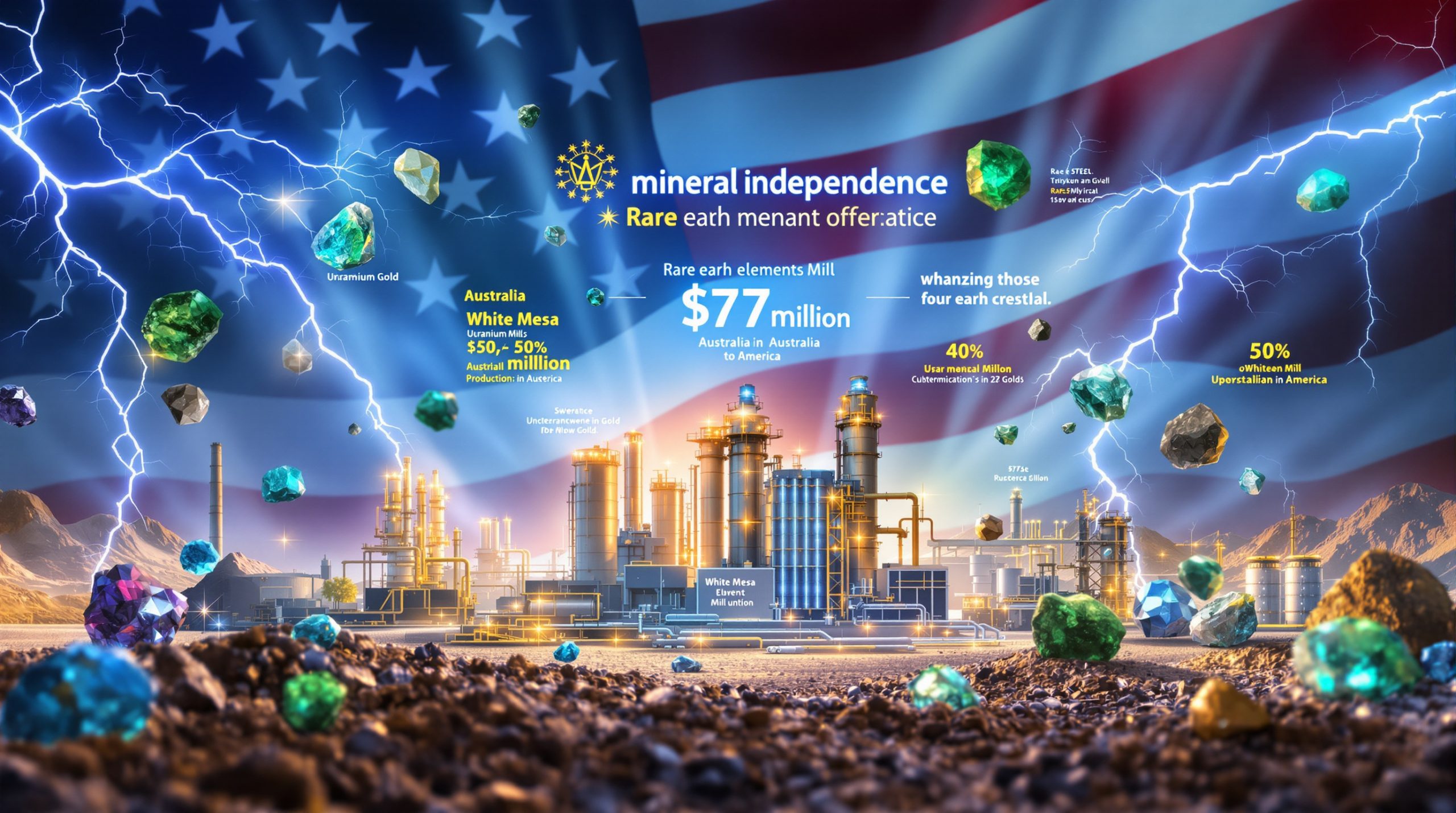Understanding the Critical Minerals Landscape
The Strategic Importance of Uranium and Rare Earths
The global transition to clean energy and advanced technologies has elevated uranium and rare earth elements (REEs) to strategic importance. Uranium powers nuclear energy—a reliable, carbon-free baseload power source that currently generates approximately 9% of global electricity according to the International Energy Agency. Meanwhile, rare earths have become essential components in everything from electric vehicles to defense systems.
Companies operating in these sectors face unique opportunities and challenges requiring specialized business approaches. A typical 3 MW wind turbine requires approximately 600 kg of neodymium-praseodymium magnets, while electric vehicles need roughly 1 kg of rare earth magnets per vehicle—creating sustained demand growth as these technologies scale.
The defense sector represents another critical demand source, with rare earths used extensively in guided munitions, radar systems, and aerospace applications. As global tensions rise, defense procurement agencies increasingly prioritize secure supply chains for these materials.
For uranium producers, the growing recognition of nuclear power's role in achieving climate goals has shifted market dynamics favorably. Even countries previously committed to phasing out nuclear power are reconsidering their positions, with many extending plant lifetimes and planning new reactor builds.
Market Dynamics and Supply Chain Vulnerabilities
The markets for both uranium and rare earths are characterized by significant supply chain vulnerabilities. China controls approximately 70% of global rare earth mining and 85-90% of rare earth processing capacity, creating a near-monopoly on these critical materials. This concentration creates pricing power and potential supply disruptions during geopolitical tensions.
Non-Chinese rare earth materials command significant premium pricing, particularly for heavy rare earths like dysprosium and terbium, which can trade at 3-4x the price of Chinese material. Neodymium-praseodymium (NdPr) oxide prices have recently increased to $85-90 per kilogram, up from $55 earlier in the year, reflecting growing concerns about supply security.
Meanwhile, uranium supply chains face disruption from geopolitical tensions, particularly with Russia's significant market share. Russia supplied approximately 12% of global uranium in 2023 but controls about 44% of global enrichment capacity—a critical bottleneck in the nuclear fuel cycle. This vulnerability became especially apparent following sanctions and trade restrictions.
Western nations have responded with initiatives to diversify critical mineral supply chains. The U.S. Inflation Reduction Act includes provisions requiring critical minerals sourcing from domestic or free trade agreement countries for electric vehicle tax credits. Similar policies in Europe, Japan, South Korea, and Australia are creating policy-driven demand for non-Chinese supply chains.
China's export controls on related materials like gallium and germanium in 2023 further demonstrated the vulnerability of global technology supply chains dependent on single-source suppliers, accelerating diversification efforts.
How Are Leading Companies Structuring Their Uranium Operations?
Leveraging Existing Infrastructure for Cost Efficiency
Companies with established uranium processing facilities possess significant competitive advantages in today's volatile uranium market. These facilities typically require $500 million to over $1 billion in capital investment and 5-10 years for permitting and construction—creating substantial barriers to entry for new competitors.
Leading uranium processors can achieve processing capacity of approximately 240,000 pounds of recovered uranium per month when operational. This throughput capacity allows them to quickly respond to market opportunities and process uranium from multiple sources.
The White Mesa Mill in Utah represents the only operating conventional uranium mill in the United States, with licensing to process up to 8 million pounds of uranium per year. This unique regulatory position allows the facility to process material from multiple mines, enabling operators to maximize facility utilization and spread fixed costs across greater production volumes.
Conventional milling involves multiple steps: crushing ore, leaching with sulfuric acid, solvent extraction, precipitation, and drying to produce uranium concentrate (U₃O₈) or "yellowcake." Companies with this infrastructure in place avoid the lengthy permitting and construction timeline that new entrants face.
Furthermore, established mills often have the flexibility to process different ore types, allowing operators to blend feedstocks to optimize recoveries and manage variability in ore characteristics—a significant operational advantage in maximizing economic returns.
Production Scaling Strategies
Successful uranium producers implement phased scaling strategies that align with market conditions:
| Production Phase | Typical Output (lbs U₃O₈) | Strategic Purpose |
|---|---|---|
| Initial | 1.0-1.5 million | Establish market presence |
| Intermediate | 1.5-2.0 million | Achieve economies of scale |
| Advanced | 2.0+ million | Maximize revenue generation |
This graduated approach allows companies to build production capacity while managing capital expenditure and responding to market pricing signals. U.S. uranium producers are currently implementing production ramp-up plans, scaling from approximately 1 million pounds last year toward 2 million pounds, with capability to exceed that level as market conditions warrant.
Production ramp-up typically begins with highest-grade, lowest-cost mines to generate early cash flow that can fund additional development. For example, the Pinyon Plain mine is currently in production with "great production, great grades," while other assets like Pandora and La Sal are being brought online in a phased approach.
Leading producers focus on maintaining flexibility to adjust production rates based on contract pricing and spot market conditions. This adaptability is crucial in the volatile uranium market, where pricing can fluctuate significantly over relatively short periods.
Low-Cost Production Focus
The uranium market has historically experienced significant price volatility, ranging from lows near $18/lb U₃O₈ in 2016 to highs above $140/lb in 2007, with current prices around $82/lb as of October 2024. Successful operators prioritize developing and maintaining low-cost production assets that remain profitable even during pricing downturns.
Key strategies include:
- Utilizing in-situ recovery (ISR) where geologically feasible, which typically reduces operating costs by 30-50% compared to conventional mining
- Focusing on high-grade deposits to maximize yield per ton processed, reducing unit costs
- Implementing operational efficiencies through automation and process optimization
- Maintaining multiple production centers to optimize blending and processing
In-situ recovery involves injecting leaching solution through wells into permeable sandstone ore bodies, recovering uranium-bearing solution, and processing it at surface facilities. This method eliminates the need for traditional mining infrastructure and significantly reduces waste rock handling.
High-grade uranium deposits (>0.1% U₃O₈) dramatically improve processing economics by reducing tonnage requirements per pound of uranium produced. This focus on grade is particularly important in conventional mining operations where material handling costs represent a significant portion of total costs.
Companies utilizing US ISR technology position themselves to remain profitable throughout market cycles and maintain operational continuity during pricing downturns—a key competitive advantage in the volatile uranium market.
What Makes Rare Earth Operations Commercially Viable?
Strategic Mineral Selection and Focus
Not all rare earth elements offer equal commercial opportunity. Leading companies strategically focus on the most critical and valuable elements:
- Neodymium (Nd) and Praseodymium (Pr): Essential for permanent magnets used in electric vehicles and wind turbines
- Dysprosium (Dy) and Terbium (Tb): Critical heavy rare earths that enhance magnet performance at high temperatures
- Samarium (Sm): Used in specialized magnets for defense applications
Neodymium-praseodymium (NdPr) oxide accounts for approximately 80-90% of rare earth permanent magnet value despite representing only about 30% of rare earth content by weight. Global NdPr demand is projected to grow from approximately 40,000 tonnes in 2023 to over 100,000 tonnes by 2035, driven primarily by electric vehicles and wind turbines.
Dysprosium and terbium are among the scarcest rare earths, with combined annual production of approximately 2,500 tonnes globally compared to 250,000+ tonnes for total rare earth oxides. These heavy rare earths are critical for high-temperature magnet performance in automotive applications where magnets experience temperatures exceeding 150°C.
By prioritizing these high-value elements, companies can maximize revenue potential while meeting critical market demands. The Donald project in Australia, for instance, is noted for having "extraordinarily high" grades of dysprosium and terbium, making it particularly valuable for heavy rare earth production.
Monazite vs. Bastnäsite Processing Strategies
The source mineral significantly impacts rare earth processing economics. Industry leaders recognize the distinct advantages of different rare earth-bearing minerals:
| Mineral | Advantages | Challenges |
|---|---|---|
| Monazite | Higher concentrations of heavy REEs (Dy, Tb) | Contains naturally occurring radioactive materials |
| Bastnäsite | Lower radioactivity | Limited heavy REE content |
| Ionic Clay | Easier extraction process | Generally lower overall grades |
Monazite typically contains 50-68% total rare earth oxides (TREO), with 2-5% heavy rare earths, plus 6-12% thorium oxide and 0.2-0.5% uranium oxide. This makes it particularly valuable for recovering critical heavy rare earths like dysprosium and terbium.
In contrast, bastnäsite typically contains 70-75% TREO but less than 0.1% heavy rare earths, with minimal radioactive content. While easier to process from a regulatory perspective, bastnäsite lacks the valuable heavy rare earth content that commands premium pricing.
Companies with uranium processing expertise have a competitive advantage in handling monazite, which contains thorium and uranium but offers superior heavy rare earth content. This creates natural synergies between uranium and rare earth operations, as existing permits and radiation handling protocols can be applied to monazite processing.
The Chinese rare earth industry has long recognized monazite's value, developing a "sustainable monazite strategy" that leverages its heavy rare earth content. Western companies with radiation handling capabilities are uniquely positioned to process monazite outside of China, addressing a critical gap in non-Chinese supply chains.
Vertical Integration Opportunities
The rare earth value chain offers multiple integration points that can enhance profitability:
- Mining and initial concentration: Extracting and concentrating rare earth-bearing minerals
- Chemical processing: Converting concentrates to mixed rare earth carbonates or oxides
- Separation: Isolating individual rare earth elements
- Metal and alloy production: Converting oxides to metals and specialized alloys
- Magnet manufacturing: Producing end-use permanent magnets
Each integration step potentially adds 30-100% in margin, with downstream activities generally offering higher returns. For example, separated rare earth oxides typically command a 50-70% premium over mixed rare earth concentrates, while metals and alloys add another 30-50% in value.
Forward-thinking companies are strategically evaluating which steps offer the optimal balance of capital investment and return potential. Some companies focus exclusively on mining and initial concentration, while others pursue vertical integration through separation or even metal production.
The challenge for Western companies is that much of the downstream infrastructure (metals, alloys, magnets) currently doesn't exist outside China. This creates opportunities for strategic partnerships with companies like South Korea's POSCO, which can produce metals, alloys, and centered magnets that go into electric vehicles.
How Can Companies Successfully Combine Uranium and Rare Earth Strategies?
Leveraging Operational Synergies
The most successful integrated uranium and rare earth companies capitalize on operational synergies:
- Shared processing infrastructure: Utilizing existing uranium processing facilities for rare earth extraction
- Radioactive material handling expertise: Applying uranium handling protocols to process monazite, which contains thorium and uranium
- Permitting advantages: Leveraging existing permits and regulatory relationships to expedite rare earth operations
- Technical workforce: Utilizing specialized metallurgical expertise across both operations
These synergies can significantly reduce capital requirements and accelerate time-to-market for rare earth products. Companies with established uranium facilities can add rare earth processing capabilities at a fraction of the cost of greenfield development.
Monazite processing requires licenses to handle naturally occurring radioactive materials (NORM), creating regulatory barriers that limit competition. Companies already operating under nuclear regulatory frameworks have a substantial head start in navigating these requirements.
The technical expertise required for uranium recovery overlaps significantly with the skills needed for monazite processing, allowing companies to leverage their existing technical workforce across both operations. This knowledge transfer reduces training costs and accelerates process development.
Diversified Revenue Streams
An integrated approach creates multiple revenue streams that can offset market volatility in either sector:
[Uranium Production] → [Cash Flow Generation] → [Funds Rare Earth Development]
↓
[Diversified Revenue Streams]
↑
[Rare Earth Production] → [Value-Added Processing] → [Premium Products]
This diversification strategy reduces overall business risk while creating opportunities to self-fund growth initiatives without excessive dilution or debt. Leading companies describe uranium production as their "cash machine" that generates material cash to fund corporate operations across both uranium and rare earth business lines.
The ability to shift processing capacity between uranium and rare earth operations based on market conditions provides additional flexibility. In the "absence of immediate demand for rare earth," companies can maximize uranium processing to capitalize on favorable pricing, then switch to rare earth processing when market conditions warrant.
This operational flexibility creates a natural hedge against market volatility in either sector, allowing companies to optimize revenue generation based on prevailing market conditions and contract opportunities.
Building Strategic Partnerships
Successful companies recognize that partnerships can accelerate market penetration and reduce development risks:
- Offtake agreements: Securing long-term contracts with end-users to support project financing
- Technology partnerships: Collaborating with downstream processors to ensure product specifications meet market requirements
- Government relationships: Engaging with critical minerals strategy initiatives to access grants, loans, and other support mechanisms
- Cross-border alliances: Forming international partnerships to create non-Chinese supply chains
Strategic partnerships with companies like South Korea's POSCO can accelerate market acceptance by demonstrating complete supply chain integration. For example, POSCO has the capability to produce centered blocks for approximately 3,500 electric vehicles using material from Western rare earth producers—proving commercial viability.
These partnerships create value by connecting production capabilities with market demand while potentially providing development capital. They also help address the "chicken-and-egg" problem in establishing new supply chains: end-users want secure supply before committing, while producers need committed customers to justify investment.
By forming strategic alliances across the value chain, companies can create viable non-Chinese supply chains that don't "touch China" at any point—a key requirement for many defense and strategic applications.
What Financing Strategies Support Growth in These Sectors?
Creative Capital Structures
The capital-intensive nature of uranium and rare earth projects requires innovative financing approaches:
- Convertible instruments: Offering lower interest rates with potential equity upside
- Project-specific financing: Securing funding for individual projects rather than corporate-level debt
- Strategic investor participation: Engaging with end-users who have strategic interests in supply security
- Government support programs: Leveraging critical minerals initiatives from agencies like the U.S. Department of Defense
Leading companies have successfully deployed convertible notes with attractive terms, such as 0.75% coupon rates, reflecting investor confidence in the sector's growth potential. These instruments provide capital at favorable rates while managing dilution through features like cap call options that limit conversion at higher share prices.
The convertible structure allows companies to raise substantial capital—up to $700 million in recent transactions—with minimal interest burden, preserving cash flow for operations and development. Strategic capital deployment focuses on ready-to-build projects rather than early-stage exploration, accelerating time-to-market.
Project-specific financing structures can ring-fence risk and potentially access specialized funding sources like export credit agencies, infrastructure funds, or critical minerals incentive programs. This approach allows companies to optimize capital structure for each project based on its specific risk profile and strategic importance.
Phased Development Approaches
Rather than pursuing full-scale development immediately, leading companies implement phased approaches that match capital deployment with risk reduction:
- Pilot phase: Small-scale operations demonstrating technical viability
- Commercial demonstration: Medium-scale production establishing market acceptance
- Full-scale deployment: Comprehensive operations achieving economies of scale
This staged approach allows companies to validate technical and market assumptions before committing to full capital expenditure, reducing overall project risk. For example, companies might process initial rare earth concentrates at existing facilities before investing in dedicated separation plants.
Phase 1 development typically focuses on highest-return opportunities with lowest technical risk—often processing readily available feedstock through existing infrastructure. Phase 2 expansions add dedicated capacity and more complex processing steps once initial operations have demonstrated commercial viability.
By breaking development into discrete phases with clear decision points, companies can secure incremental funding based on demonstrated success rather than speculative projections. This approach is particularly valuable in emerging sectors where technology risk and market acceptance remain significant variables.
What Are the Key Challenges in Implementing These Strategies?
Technical Processing Complexities
Both uranium and rare earth processing involve complex metallurgical challenges:
- Uranium processing: Managing radiation protection, tailings disposal, and recovery optimization
- Rare earth separation: Achieving high purity levels for individual elements with similar chemical properties
- Heavy rare earth extraction: Developing cost-effective methods for separating the most valuable elements
Rare earth separation is particularly challenging due to the chemical similarity of adjacent lanthanides, requiring hundreds of extraction stages to achieve high purity. Conventional rare earth separation uses solvent extraction with specific extractants for each element, requiring extensive process development and optimization.
Companies must invest in technical expertise and proprietary process development to overcome these challenges. This includes specialized metallurgical teams with experience in both conventional and novel separation technologies, as well as process engineering capability for scaling laboratory results to commercial production.
Developing cost-effective separation processes for heavy rare earths like dysprosium and terbium represents a particular challenge, as these elements are present in smaller quantities and have more complex separation characteristics. However, their high value (3-4x premium over Chinese prices) justifies the additional processing complexity.
Regulatory Navigation
The regulatory landscape for these materials involves multiple overlapping frameworks:
- Nuclear regulations: Governing uranium handling, processing, and transportation
- Environmental permits: Addressing waste management and environmental protection
- Export controls: Managing international shipments of strategic materials
- Product certifications: Meeting end-user specifications and quality standards
Companies processing monazite face particular regulatory complexity due to its naturally occurring radioactive materials content. Facilities must operate under nuclear regulatory frameworks while also meeting environmental standards for waste management and disposal.
International shipments require specialized logistics providers experienced in Class 7 (radioactive) material transportation. Companies with experience in uranium transportation can leverage this expertise for monazite shipments, creating another operational synergy between uranium and rare earth operations.
Successful operators develop comprehensive regulatory strategies that address these requirements while maintaining operational flexibility. This includes proactive engagement with regulatory agencies, transparent communication with local communities, and investment in specialized environmental management systems.
Market Development Efforts
Establishing new supply chains outside of China requires coordinated market development:
- Product qualification: Working with customers to validate material specifications
- Supply chain certification: Documenting ethical and sustainable production practices
- Price discovery mechanisms: Establishing transparent pricing for non-Chinese materials
- End-user education: Helping customers understand the value of supply chain diversification
Many potential end-users have limited experience working with non-Chinese rare earth suppliers, requiring extensive product qualification and testing before commercial adoption. This process can take 6-18 months for critical applications, creating a significant time lag between production capability and commercial revenue.
Rare earth products must meet precise specifications for each application, requiring close collaboration between producers and end-users during development. This includes detailed chemical analysis, physical property testing, and performance validation in end-use applications.
Companies must also educate potential customers about the strategic value of supply chain diversification, as non-Chinese materials may command price premiums over Chinese alternatives. This value proposition focuses on supply security, traceability, and ethical production practices rather than simply competing on price.
How Are Global Market Trends Shaping Future Strategies?
Geopolitical Realignment of Supply Chains
The global push for supply chain security is creating new opportunities:
- Western government initiatives: Programs supporting domestic and allied-nation production
- "China+1" strategies: End-users seeking alternative suppliers to reduce dependency
- Premium pricing: Non-Chinese materials commanding 3-4x price premiums for certain elements
- Strategic stockpiles: Government and corporate inventory building creating additional demand
The U.S. Department of Defense has identified rare earth elements and uranium as critical materials for national security, creating funding opportunities through programs like the Defense Production Act Title III. Similar initiatives exist in Canada, Australia, and European nations, reflecting shared concerns about critical mineral security.
Corporate "China+1" strategies represent a significant market driver, as manufacturers seek to diversify supply chains even if alternative sources cost more than Chinese materials. This trend accelerated following COVID-19 supply chain disruptions and has gained further momentum with increasing geopolitical tensions.
Premium pricing for non-Chinese materials, particularly heavy rare earths like dysprosium and terbium, creates economic incentives for Western production even at smaller scales. With heavy rare earths trading at 3-4x Chinese prices for non-Chinese material, projects with significant heavy rare earth content can achieve favorable economics despite higher operating costs.
Integration with Broader Critical Minerals Strategies
Forward-thinking companies are exploring synergies with other critical mineral operations:
- Heavy mineral sands: Extracting titanium minerals (ilmenite, rutile) and zircon alongside monazite
- Lithium and cobalt: Creating broader critical minerals hubs serving multiple clean energy sectors
- Graphite and manganese: Developing comprehensive battery materials supply chains
The Donald project in Australia represents this integrated approach, recovering ilmenite, rutile, and zircon as primary products while directing 100% of the monazite to rare earth processing. This co-production model improves overall project economics by distributing mining and processing costs across multiple revenue streams.
Creating comprehensive critical minerals hubs allows companies to leverage shared infrastructure, technical expertise, and regulatory frameworks across multiple commodities. This approach creates economies of scale that improve competitiveness while offering customers one-stop access to multiple strategic materials.
As Western nations develop critical minerals strategies, companies offering integrated solutions across multiple materials can access broader support programs and customer relationships. This positions them as strategic partners rather than commodity suppliers—enhancing both market position and corporate valuation.
What Does Success Look Like in This Sector?
Balanced Portfolio Development
The most successful operators in this space will develop balanced portfolios that:
- Maintain uranium as a core cash-generating business
- Develop rare earth capabilities focusing on high-value elements
- Create integration points that maximize margin capture
- Maintain operational flexibility to respond to market shifts
- Establish diverse geographic footprints in stable jurisdictions
This balanced approach provides both near-term cash flow and long-term growth potential. Uranium operations generate immediate revenue and cash flow, funding corporate operations while rare earth and other strategic initiatives are developed to commercial scale.
Geographic diversification across stable jurisdictions (U.S., Australia, Canada) reduces country-specific risk while positioning operations to benefit from multiple government support programs. This approach also creates flexibility in sourcing feedstock from the most economically favorable locations based on market conditions.
Successful companies will maintain the flexibility to adjust operations based on market conditions, shifting resources between uranium and rare earth processing depending on pricing and customer demand. This operational flexibility creates resilience against market volatility while maximizing asset utilization.
Strategic Position in Western Supply Chains
Ultimate success involves securing a pivotal role in Western supply chains through:
- Becoming a trusted supplier to defense and critical infrastructure sectors
- Establishing long-term partnerships with major end-users in renewable energy and electric vehicle markets
- Developing proprietary processing capabilities that are difficult to replicate
- Creating a recognized brand for responsibly produced critical minerals
Companies that achieve these strategic positions will command premium valuations and sustainable competitive advantages. The most successful operators will move beyond commodity production to become strategic partners in supply chain security—a position that justifies premium pricing and long-term commitments from customers.
Defense sector relationships offer particular strategic value, as military specifications often require domestic or allied-nation sourcing regardless of cost premiums. Companies that can meet these requirements face limited competition and relatively stable demand profiles insulated from commercial market volatility.
By developing proprietary processing technologies and integrated supply chains, leading companies can create sustainable competitive advantages that extend beyond simple cost leadership. These advantages include customer-specific product formulations, specialized processing capabilities, and unique integration points across the value chain.
Building a Resilient Critical Minerals Business
The intersection of uranium and rare earths offers unique strategic opportunities for companies with the technical capabilities and vision to execute effectively. Success requires balancing near-term production with long-term development, managing complex regulatory environments, and creating strategic partnerships across global supply chains.
Companies that leverage operational synergies between uranium and rare earth processing can achieve significant cost advantages while accelerating time-to-market for critical products. The ability to process monazite—with its valuable heavy rare earth content and naturally occurring radioactive materials—creates a defensible competitive position that few companies can replicate.
As nations increasingly prioritize secure access to these materials, companies that can deliver reliable, ethically sourced supplies from stable jurisdictions will find themselves in increasingly advantageous positions. The premium pricing currently available for non-Chinese rare earth materials (3-4x for heavy rare earths) creates economic incentives for Western production even at smaller scales.
The key to success lies in developing integrated uranium investment trends that leverage operational synergies while maintaining the flexibility to adapt to evolving market conditions. By creating diversified revenue streams across uranium, rare earths, and potentially other critical minerals, companies can reduce overall business risk while positioning themselves for sustainable growth.
Disclaimer: This article contains forecasts and analysis of developing markets for uranium and rare earth elements. These markets are subject to significant volatility influenced by geopolitical factors, regulatory changes, and technological developments. Readers should conduct their own research before making investment or business decisions based on information presented.
Ready to Spot the Next Major Mineral Discovery?
Be the first to know when significant mineral discoveries break on the ASX with Discovery Alert's proprietary Discovery IQ model, providing real-time alerts to potentially market-moving announcements. Explore how major discoveries have generated substantial returns by visiting our discoveries page and gain your competitive advantage today.




